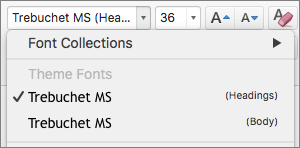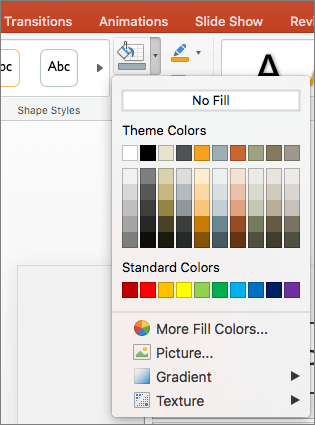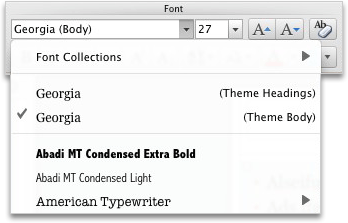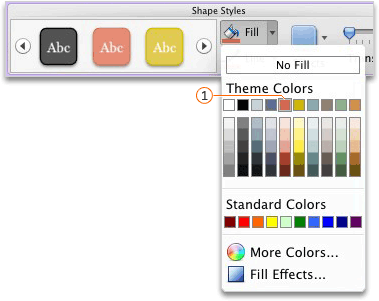Apply multiple themes to a presentation
If the theme of a presentation doesn't work on all the slides, you can apply a different theme, such as a plain white theme, to selected slides. For example, if you add a slide with multiple text boxes and graphics, theme fonts might cause text to wrap differently and graphics might partially cover theme elements. In this case, a plain white theme can simplify the slide.
Apply a different theme to a slide
-
Select the slide that you want to apply a different theme to.
-
Hold down CONTROL and then, on the Design tab, in Themes, click the slide that you want to apply the theme to and click Apply to Selected Slides.
Tip: If your goal is to display very little or no color on the slide (a plain look), apply the White theme.
Return manually formatted elements to theme settings
A theme is a collection of specific fonts, colors, and slide layout. When any of these elements is formatted manually, that formatting overrides the theme. For example, if your presentation uses the Courier font and you manually format some of the text as Tahoma, reapplying or changing the theme will not affect the text that is formatted with the Tahoma font.
To return manually formatted elements to the theme settings, see the following sections:
Restore a font to the theme font
Each theme has two sets of fonts, one for headings and another for body text. If your text is a heading, use the Theme Headings font. Otherwise, use the Theme Body font.
-
Select the text that you want to change to a theme font.
Tip: You can hold down SHIFT to select more than one text box or object that contains text. If you can't select an object or text on a slide, modify the slide master.
-
On the Home tab, in Font, click the arrow next to the font name box.
-
To change text to a theme font, click the Theme Headings font or the Theme Body font.
A check mark shows that the Theme Headings font or the Theme Body font is selected.

Restore theme colors to objects
If you apply a theme and some objects do not change to theme colors, they probably have manual formats applied.
-
Select the object for which you want to restore theme colors.
-
On the Format tab, in Shape Styles, click the arrow next to Shape Fill, and then click the color that you want.

Restore theme layouts
If you apply a theme and some slides don't change to theme layouts, the layouts were probably changed manually. For example, if you move a heading to a different place on the slide or change the position of a table, those items have manually formatted layouts that don't change when the theme changes.
-
Click the item that you want to restore to the theme layout, such as a repositioned heading.
-
On the Home tab, in Slides, click Reset.

See also
Apply a different theme to a slide
-
Select the slide that you want to apply a different theme to.
-
Hold down CONTROL and then, on the Themes tab, under Themes, click the slide that you want to apply the theme to, and click Apply to Selected Slides.
Tip: If your goal is to display very little or no color on the slide (a plain look), apply the White theme.
Return manually formatted elements to theme settings
A theme is a collection of specific fonts, colors, and slide layout. When any of these elements is formatted manually, that formatting overrides the theme. For example, if your presentation uses the Courier font and you manually format some of the text as Tahoma, reapplying or changing the theme will not affect the text that is formatted with the Tahoma font.
To return manually formatted elements to the theme settings, see the following sections:
Restore a font to the theme font
Each theme has two sets of fonts, one for headings and another for body text. If your text is a heading, use the Theme Headings font. Otherwise, use the Theme Body font.
-
Select the text that you want to change to a theme font.
Tip: You can hold down SHIFT to select more than one text box or object that contains text. If you cannot select an object or text on a slide, modify the slide master.
-
On the Home tab, under Font, click the arrow next to the font box.
-
To change text to a theme font, click the Theme Headings font or the Theme Body font.
A check mark shows that the Theme Headings font or the Theme Body font is selected

Restore theme colors to objects
If you apply a theme and some objects do not change to theme colors, they probably have manual formats applied.
-
Select the object for which you want to restore theme colors.
-
On the Format tab, under Shape Styles, click the arrow next to Fill, and then click the color that you want.

 A theme color, a brick red in this example, is selected for the object
A theme color, a brick red in this example, is selected for the object
Restore theme layouts
If you apply a theme and some slides do not change to theme layouts, the layouts were probably changed manually. For example, if you move a heading to a different place on the slide or change the position of a table, those items have manually formatted layouts that do not change when the theme changes.
-
Click the item that you want to restore to the theme layout, such as a repositioned heading.
-
On the Home tab, under Slides, click Layout, and then click Reset Layout to Default Settings.

No comments:
Post a Comment